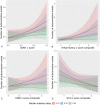Associations between smartphone keystroke dynamics and cognition in MS
- PMID: 36506490
- PMCID: PMC9730018
- DOI: 10.1177/20552076221143234
Associations between smartphone keystroke dynamics and cognition in MS
Abstract
Objective: Examine the associations between smartphone keystroke dynamics and cognitive functioning among persons with multiple sclerosis (MS).
Methods: Sixteen persons with MS with no self-reported upper extremity or typing difficulties and 10 healthy controls (HCs) completed six weeks of remote monitoring of their keystroke dynamics (i.e., how they typed on their smartphone keyboards). They also completed a comprehensive neuropsychological assessment and symptom ratings about fatigue, depression, and anxiety at baseline.
Results: A total of 1,335,787 keystrokes were collected, which were part of 30,968 typing sessions. The MS group typed slower (P < .001) and more variably (P = .032) than the HC group. Faster typing speed was associated with better performance on measures of processing speed (P = .016), attention (P = .022), and executive functioning (cognitive flexibility: P = .029; behavioral inhibition: P = .002; verbal fluency: P = .039), as well as less severe impact from fatigue (P < .001) and less severe anxiety symptoms (P = .007). Those with better cognitive functioning and less severe symptoms showed a stronger correlation between the use of backspace and autocorrection events (P < .001).
Conclusion: Typing speed may be sensitive to cognitive functions subserved by the frontal-subcortical brain circuits. Individuals with better cognitive functioning and less severe symptoms may be better at monitoring their typing errors. Keystroke dynamics have the potential to be used as an unobtrusive remote monitoring method for real-life cognitive functioning among persons with MS, which may improve the detection of relapses, evaluate treatment efficacy, and track disability progression.
Keywords: Multiple sclerosis; digital phenotyping; mHealth; passive monitoring; typing.
© The Author(s) 2022.
Conflict of interest statement
The author(s) declared the following potential conflicts of interest with respect to the research, authorship, and/or publication of this article: Alex Leow is a cofounder of KeyWise AI, has served as a consultant for Otsuka US, and is currently on the medical board of Buoy Health. These entities had no involvement in the collection, analysis and interpretation of data; writing of the report; or in the decision to submit the article for publication.
Figures





References
-
- Benedict RH, Pol J, Yasin F, et al. Recovery of cognitive function after relapse in multiple sclerosis. Mult Scler J 2021; 27: 71–78. - PubMed
-
- Heled E, Aloni R, Achiron A. Cognitive functions and disability progression in relapsing-remitting multiple sclerosis: a longitudinal study. Appl Neuropsychol Adult 2021; 28: 210–219. - PubMed
-
- Calamia M, Markon K, Tranel D. Scoring higher the second time around: meta-analyses of practice effects in neuropsychological assessment. Clin Neuropsychol 2012; 26: 543–570. - PubMed
LinkOut - more resources
Full Text Sources

